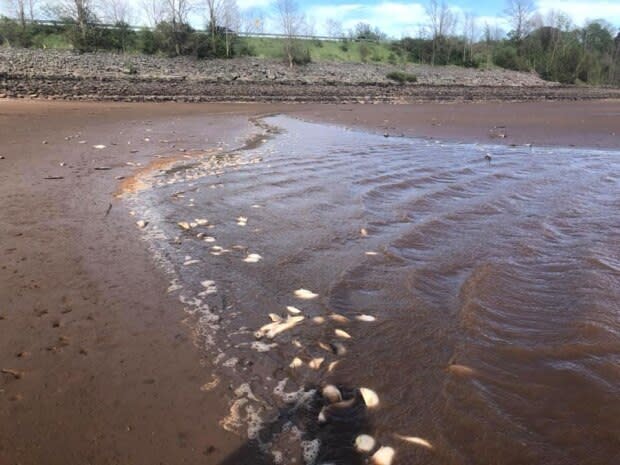Avon River fish kill leaves N.S. fisherman frustrated
A Nova Scotia fisherman is speaking out about the "catastrophic" handling of a recent fish kill around the Avon River causeway in Windsor.
The fish kill left the river bottom littered with gaspereau carcasses.
"We're at the end of our string … we cannot allow this to happen anymore," said area fisherman Darren Porter, who works with the Mi'kmaw Conservation Group collecting data on fish passage through causeways.
Porter said there appeared to be "thousands" of dead fish.
He said he first noticed the dead fish at around 1 p.m. Wednesday, but he didn't see anyone from the Department of Oceans and Fisheries on site until Saturday morning.

That left three days for seagulls and eagles to scoop up some of the carcasses, reducing the official number of dead fish for DFO to document, he said.
DFO to determine cause of death
In an email statement, a spokesperson for DFO said the department is aware that "a number" of fish were found dead in the Avon River will try to determine the cause of death.
"As this is an active area of inquiry, no other information will be made available at this time," the statement said.

Porter said the fish kill was likely due to a combination of high temperatures and a lack of water from the Nova Scotia Power generating station upstream.
"It basically robbed those rivers, during a massive migration of fish, of the water they needed to survive," Porter said.
With little water pooling on the dry river bed, and temperatures reaching into the high 20s for most of the week, Porter said the fish suffocated and died in a "muddy soup" outside the causeway gates.
But Amber Rethman, a spokesperson for Nova Scotia Power, said in an email that operations were running normally, keeping "appropriate" water levels for this time of year. "This was not a contributing factor to the fish mortality," she said "We work closely with fishers and will continue to engage with them."
'Catastrophic' response
Porter said the causeway gates were closed after the fish kill and the lake was raised, "covering up" the sight of the dead fish.
The closed gates are now blocking the next main run of hundreds of thousands of gaspereau, which Porter calls a "catastrophic" side-effect of the way the situation has been handled.

Porter said he has been in contact with lawyers and plans to take DFO to court if they continue to block the run of gaspereau.
While DFO is the federal body responsible for the management and control of fisheries and the conservation of fish and fish habitat, the causeway structure is operated by the Nova Scotia Department of Agriculture.
Agriculture Minister Keith Colwell said in an email his department is working closely with DFO to adjust operations at the causeway to "mitigate impacts to fish or habitat."
He said, as of Friday night, the causeway's operations shifted to keep a set lake level of between three and four feet, to "prevent dry locations or stranded pools along the watershed." That is consistent with seasonal operations the department has observed for years, he said.
MORE TOP STORIES


